Original Title: Stablecoin Playbook: Flipping Billions to Trillions
Original Author: Rui Shang, Medium writer
Original Translation: zhouzhou, BlockBeats
Editor's Note: Stablecoins are driving a revolution in the financial system, showcasing immense potential, especially in enhancing payment efficiency, cross-border transactions, and the foreign exchange market. Traditional foreign exchange systems face high costs, low efficiency, and settlement risks, while blockchain-based foreign exchange offers low-cost, instant settlement, and transparency, significantly improving the efficiency of capital flow. The proliferation of stablecoins not only enhances the convenience of cross-border payments but also provides financial inclusion for underbanked markets.
The following is the original content (reorganized for readability):
Introduction:
The younger generation is digital natives, and stablecoins are their natural currency. As artificial intelligence and the Internet of Things drive billions of automated microtransactions, the global financial system needs more adaptive currency solutions. Stablecoins, as a "currency API," transmit seamlessly like internet data, reaching a transaction volume of $4.5 trillion in 2024. This figure is expected to grow as more institutions recognize stablecoins as an unparalleled business model—Tether made $5.2 billion in profits in the first half of 2024 by investing its reserves.
In the competition for stablecoins, distribution and true adoption are key, rather than complex cryptographic mechanisms. Their adoption unfolds in three critical areas: native crypto, fully banked, and unbanked worlds.
In the $2.9 trillion native crypto world, stablecoins serve as an entry point for DeFi, widely used for trading, lending, derivatives, yield farming, and RWA. Crypto-native stablecoins compete through liquidity incentives and DeFi integration, enhancing financial efficiency in the fully banked world of over $400 trillion, primarily used for B2B, P2P, and B2C payments.
Stablecoins emphasize regulation, licensing, and distribution through banks, card networks, payments, and merchants. In the unbanked world, stablecoins provide access to the dollar, promoting financial inclusion. Stablecoins are used for savings, payments, foreign exchange, and yield generation, making entry strategies for grassroots markets crucial.
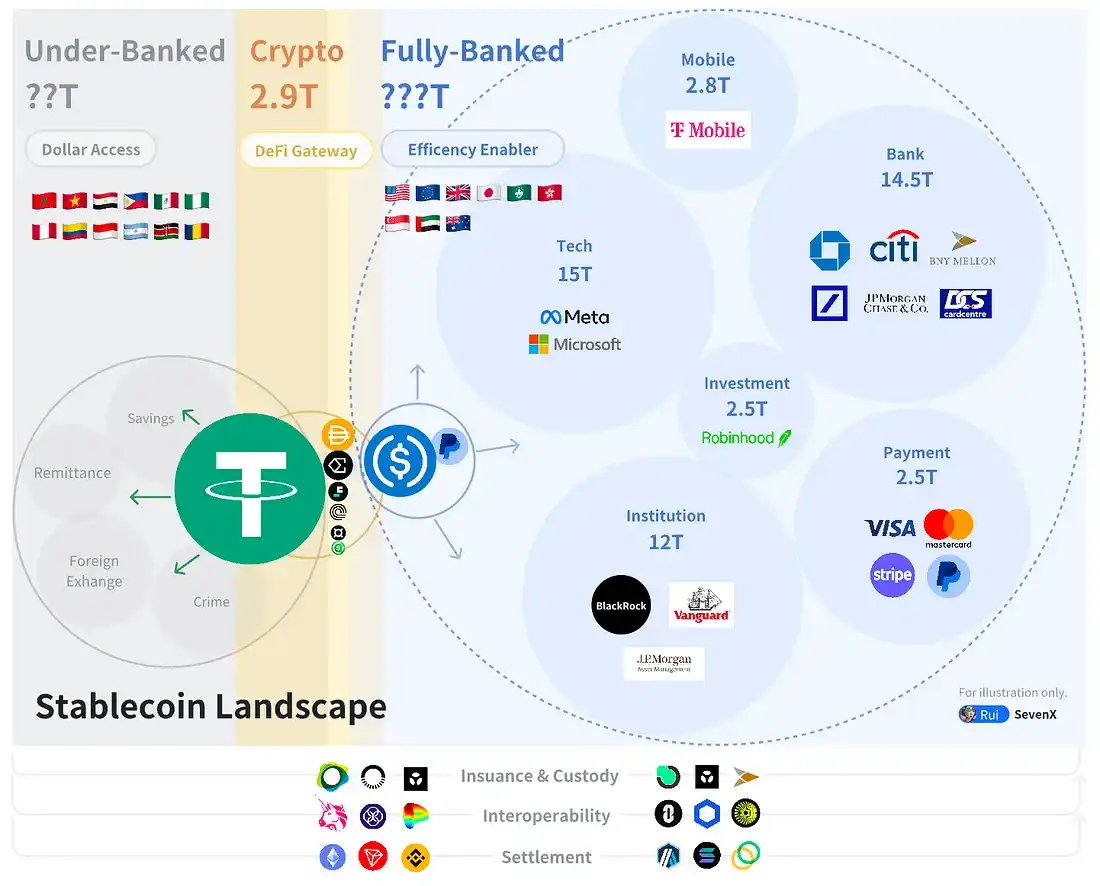
Content Outline
Introduction:
Natives of the Native Crypto World
The Battle for Stablecoin Pegging
Challenges of Liquidity Initiation
DeFi Entry: Trading Pairs, Lending, Derivatives, Yields, RWA
- Outsiders in the Fully Banked World
Dynamics of Key Players
Efficiency Drivers: B2B, P2P, C2B Payments
- Pioneers in the Unbanked World
Shadow Dollar Economy
Dollar Access: Savings, Payments, Foreign Exchange
- Conclusion: Interconnectedness
Interoperability: Cross-Currency, Cross-Token, and Cross-Chain
Opportunity Highlights and Unsolved Mysteries
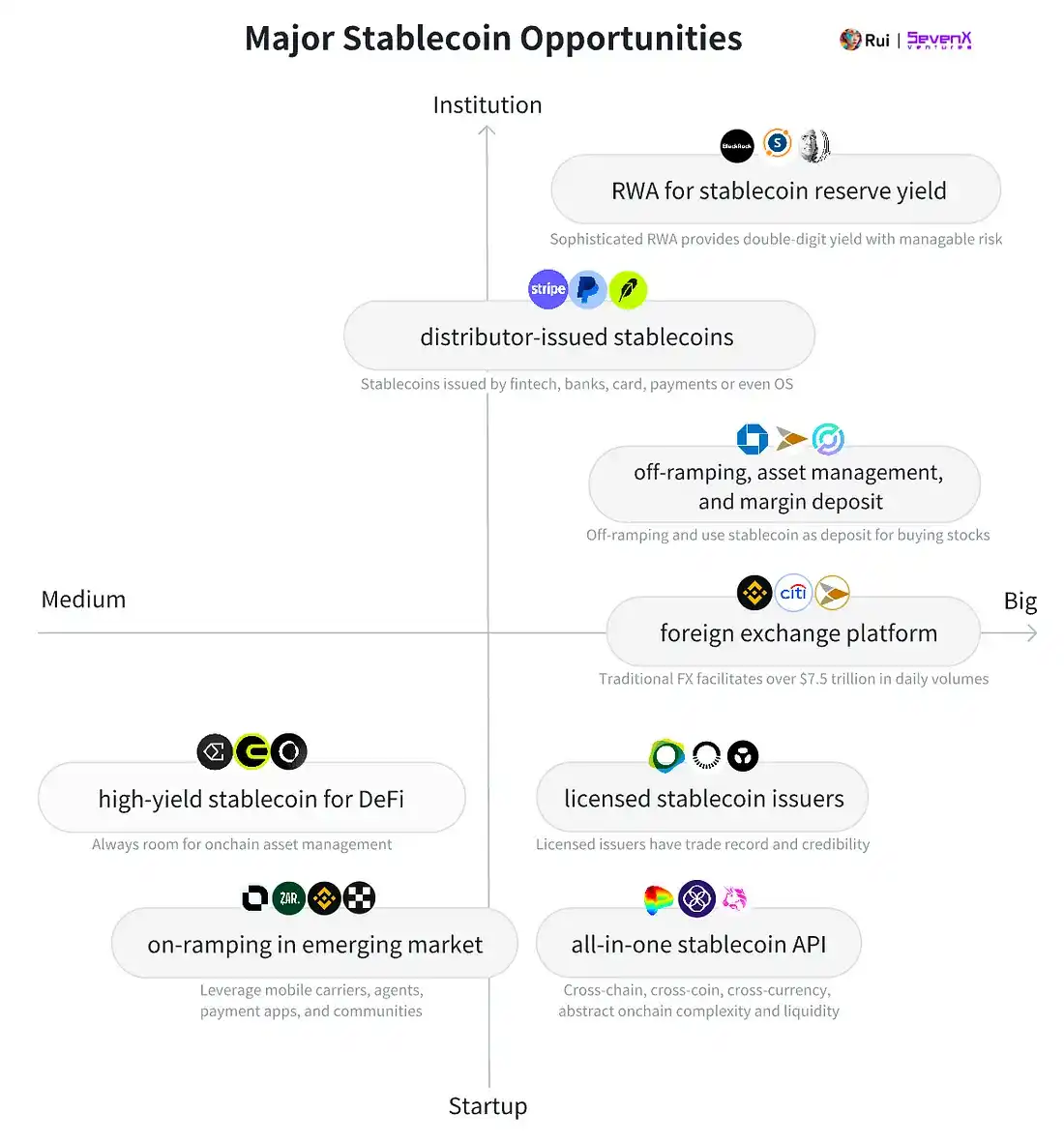
Natives of the Crypto World
In the second quarter of 2024, stablecoins accounted for 8.2% of the total market capitalization of the entire crypto market. Maintaining peg stability remains a challenge, and unique incentives are key to expanding on-chain distribution, with the current core issue being the limited use cases on-chain.
The Battle for Stable Pegging
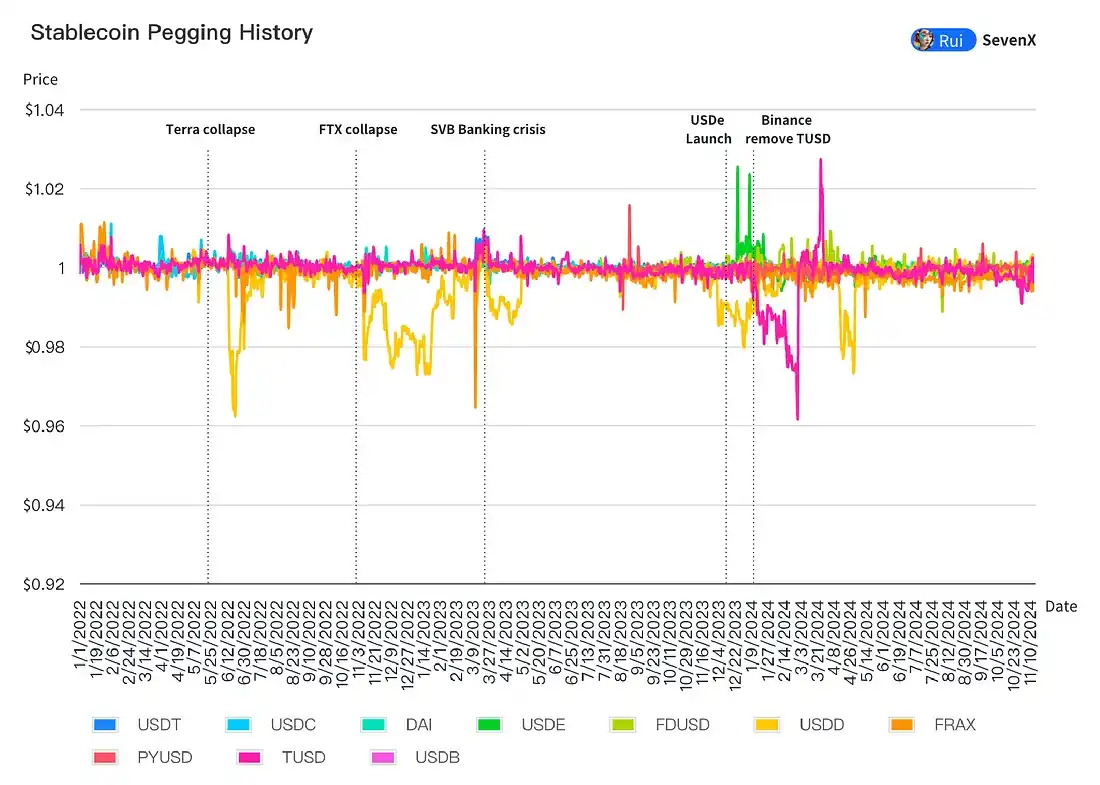
- Fiat-backed stablecoins rely on banking relationships:
93.33% of stablecoins are fiat-backed, offering higher stability and capital efficiency, with banks having the final say through control over redemptions. Regulated issuers like Paxos have become PayPal's dollar issuer due to their ability to successfully redeem billions of dollars in BUSD.
- CDP stablecoins improve collateral and liquidation mechanisms to enhance peg stability:
3.89% of stablecoins are based on collateralized debt positions (CDPs). They use cryptocurrencies as collateral but face challenges in scalability and volatility. By 2024, CDPs have improved resilience by accepting a broader range of liquidity and stable collateral.
Aave's GHO accepts any asset in Aave v3, while Curve's crvUSD recently added USDM (RWA). Some liquidation mechanisms have been improved, especially the soft liquidation of crvUSD, which uses its customized AMM to buffer against further bad debts. However, the ve-token incentive model faces difficulties, as the market cap of crvUSD shrinks when CRV valuations drop after large-scale liquidations.
- Synthetic dollars maintain stability through hedging:
Ethena USDe captured 1.67% of the stablecoin market share with a market cap of $3 billion within a year. It is a delta-neutral synthetic dollar that hedges against volatility by opening short positions in the derivatives market. Its financing rates are expected to perform well in the upcoming bull market, even after the "point season."
However, its long-term viability remains questionable due to high reliance on CEX. As similar products increase, the impact of small funds on Ethereum may diminish. These synthetic dollars may face the risk of black swan events and experience low financing rates during bear markets.
- Algorithmic stablecoins drop to 0.56%
Challenges of Liquidity Initiation
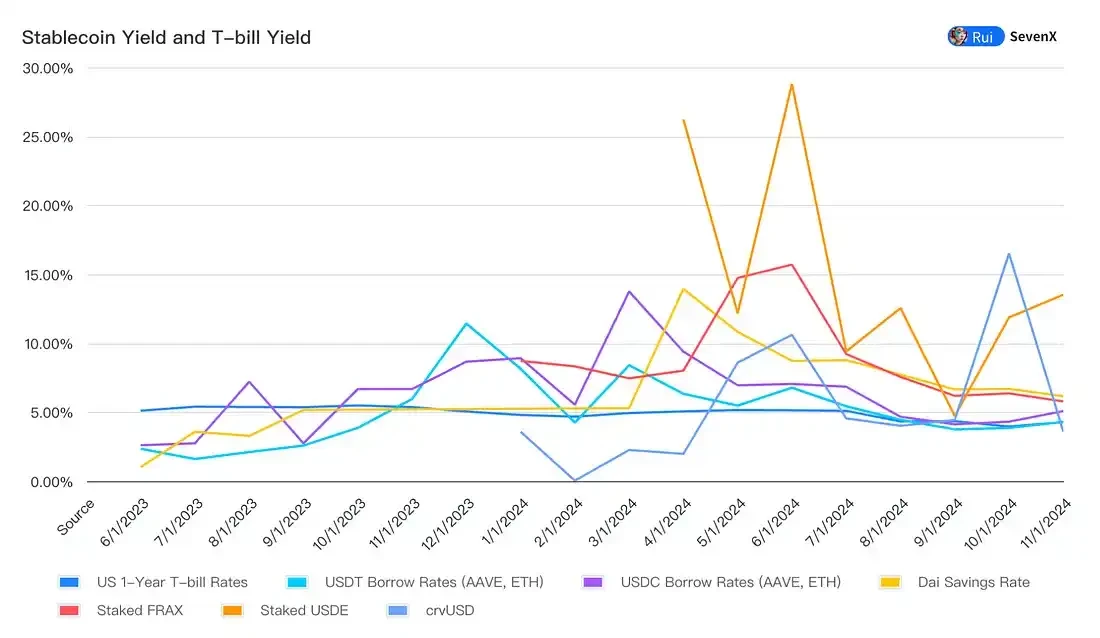 Crypto stablecoins attract liquidity through yields; fundamentally, their liquidity costs include risk-free rates and risk premiums. To remain competitive, the yields of stablecoins must at least match Treasury bill (T-bill) rates—we have seen that as T-bill rates reach 5.5%, the borrowing costs of stablecoins have decreased.
Crypto stablecoins attract liquidity through yields; fundamentally, their liquidity costs include risk-free rates and risk premiums. To remain competitive, the yields of stablecoins must at least match Treasury bill (T-bill) rates—we have seen that as T-bill rates reach 5.5%, the borrowing costs of stablecoins have decreased.
sFrax and DAI lead in T-bill exposure, and by 2024, multiple RWA projects have enhanced the composability of on-chain T-bills: CrvUSD uses Mountain's USDM as collateral, while Ondo's USDY and Ethena's USDtb are backed by BlackRock's BUIDL.
Based on T-bill rates, stablecoins have adopted various strategies to increase risk premiums, including fixed budget incentives (such as DEX issuance, facing constraints and death spirals), user fees (related to lending and perpetual contract trading volumes), volatility arbitrage (dropping when volatility decreases), and reserve utilization like staking or re-staking (less attractive).
In 2024, innovative liquidity strategies began to emerge:
Maximizing In-Block Yields:
Currently, much of the yield comes from self-consuming DeFi inflation as incentives, but more innovative strategies are emerging. By utilizing reserves as banks, projects like CAP aim to direct MEV and arbitrage profits directly to stablecoin holders, providing a sustainable and potentially more favorable source of yield.
Compounding T-bill Yields:
Leveraging the newly gained composability of RWA projects, plans like Usual Money (USD0) offer "theoretically" unlimited yields through their governance tokens, with T-bill yields as a benchmark—this attracted $350 million in liquidity providers (L) and entered the Binance Launch Pool. Agora (AUSD) is also an offshore stablecoin based on T-bill yields.
Balancing High Yields Against Volatility:
Newer stablecoins adopt diversified basket strategies to avoid single yield and volatility risks while providing balanced high yields. For example, Fortunafi's Reservoir combines T-bills, Hilbert, Morpho, and PSM, dynamically adjusting proportions and incorporating other high-yield assets as needed.
Is Your TVL a Fad?
The yields of stablecoins often face scalability issues; while fixed budget yields can trigger initial yield peaks, returns will be diluted as TVL grows, and yield effects diminish over time. Without sustainable yields or providing real utility in trading pairs and derivatives after the incentive period, their TVL may be hard to maintain.
The Dilemma of DeFi Entry
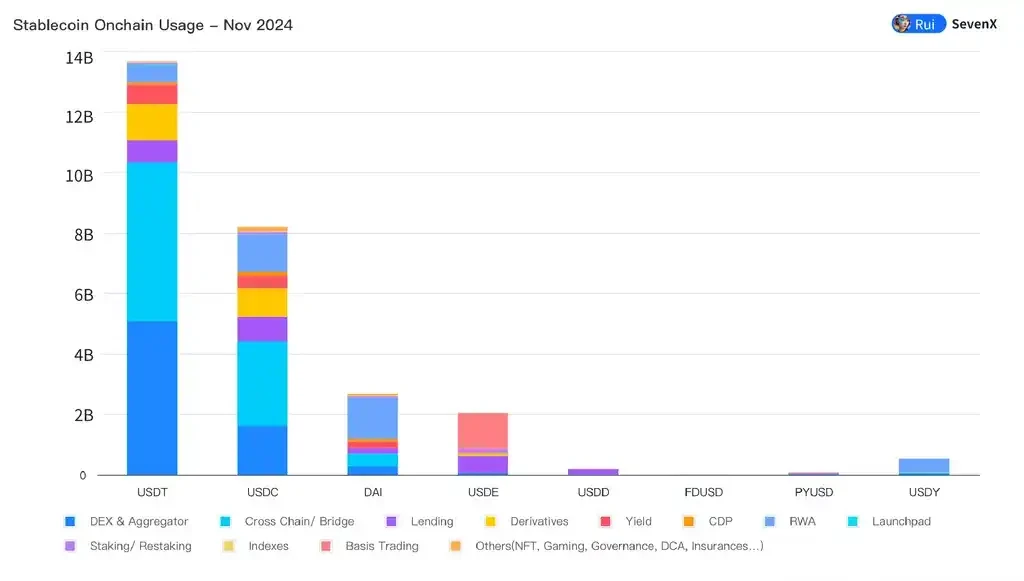
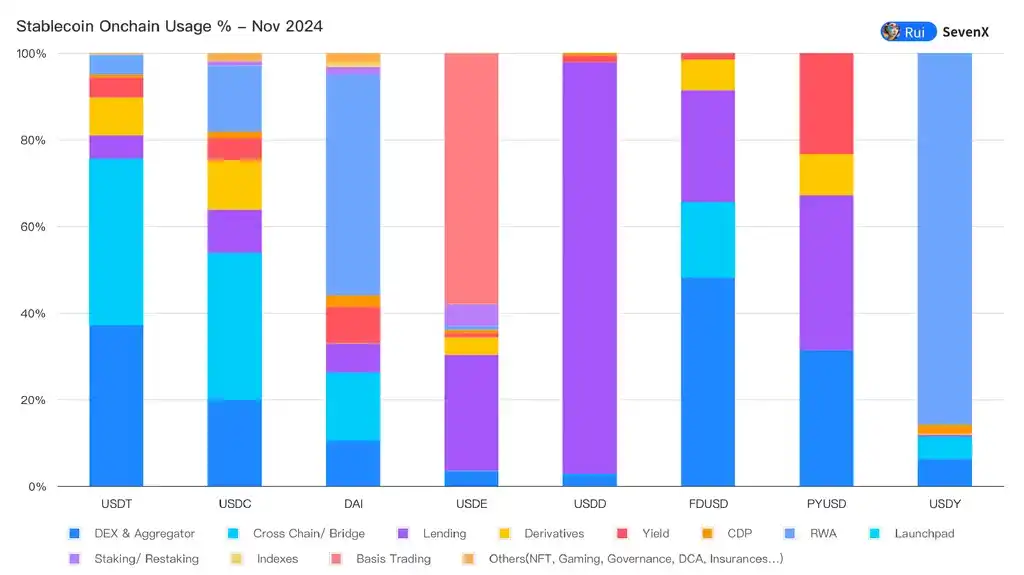
On-chain visibility allows us to examine the true nature of stablecoins: Are stablecoins genuinely used as a medium of exchange, or are they merely financial products for yield?
Only the best-interest stablecoins are used as trading pairs on CEX:
Nearly 80% of trades still occur on centralized exchanges, with top CEXs supporting their "preferred" stablecoins (e.g., Binance uses FDUSD, Coinbase uses USDC). Other CEXs rely on the overflow liquidity of USDT and USDC. Additionally, stablecoins are struggling to become margin deposits on CEXs.
Few stablecoins are used as trading pairs on DEX:
Currently, only USDT, USDC, and a small amount of DAI are used as trading pairs. Other stablecoins, such as Ethena's USDe, have 57% staked in their own protocol, held entirely as financial products for earning yields, far from becoming a medium of exchange.
Makerdao + Curve + Morpho + Pendle, allocation combinations:
Market players like Jupiter, GMX, and DYDX prefer USDC as a deposit because USDT has a more questionable minting and redemption process. Lending platforms such as Morpho and AAVE favor USDC due to its better liquidity on Ethereum. On the other hand, PYUSD is primarily used for Kamino lending on Solana, especially when incentives are provided by the Solana Foundation. Ethena's USDe is mainly used for yield activities within Pendle.
RWA is undervalued:
Most RWA platforms, like BlackRock, use USDC as a minting asset for compliance reasons; additionally, BlackRock is a shareholder in Circle. DAI has achieved success with its RWA products.
Expanding the pie or seeking new territories:
While stablecoins can attract major liquidity providers through incentives, they face bottlenecks—DeFi usage has already been declining. Stablecoins now face a dilemma: they either wait for the expansion of crypto-native activities or seek entirely new uses beyond crypto.
Outsiders in the Fully Banked World
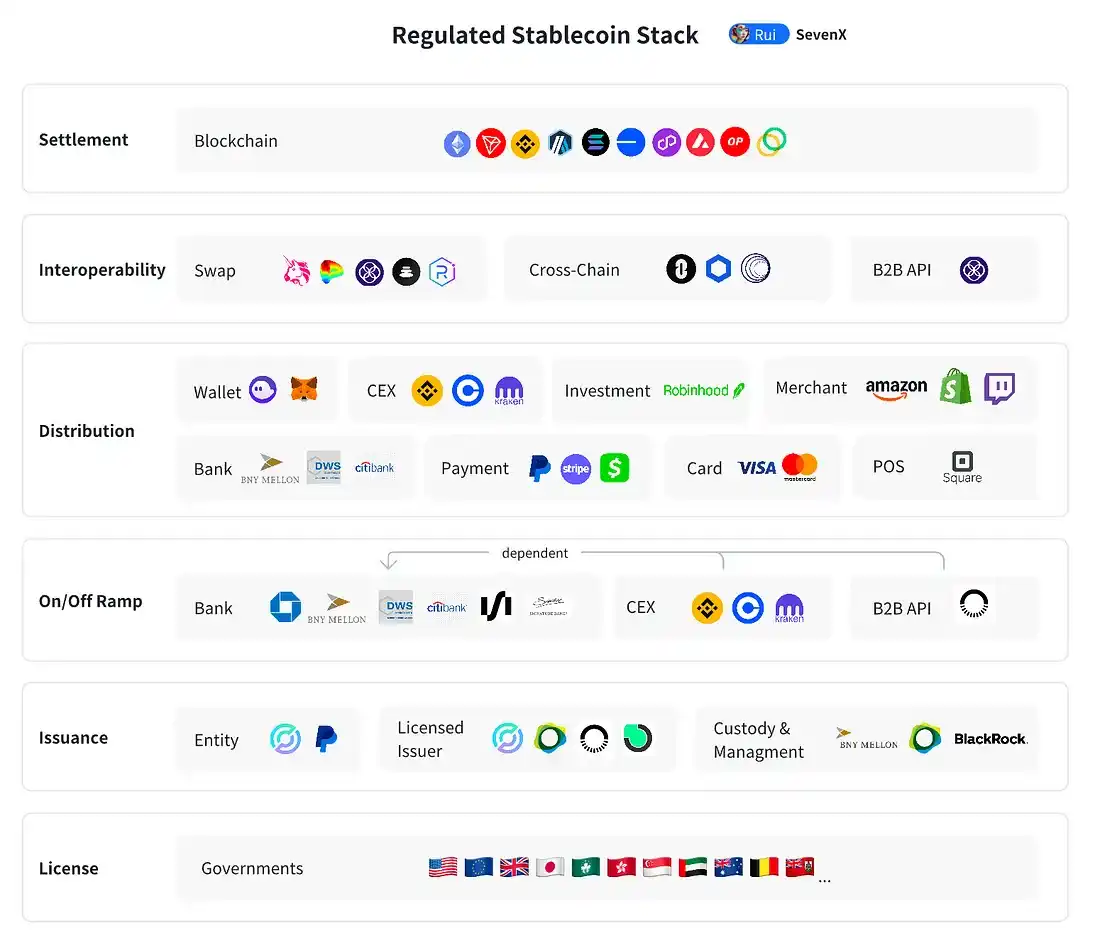
Dynamics of Key Players
Global regulation is gradually clarifying:
99% of stablecoins are dollar-backed, with the federal government having the final influence. It is expected that under President Trump's administration, the regulatory framework in the U.S. will become clearer, as Trump has promised to lower interest rates and ban CBDCs, which may benefit stablecoins. A report from the U.S. Treasury highlights the impact of stablecoins on the demand for short-term government debt, with Tether holding $90 billion in U.S. debt. Preventing crypto crime and maintaining the dollar's dominance are also among the motivations.
By 2024, multiple countries have developed regulations related to stablecoins under common principles, including approval for stablecoin issuance, reserve liquidity and stability requirements, restrictions on the use of foreign currency stablecoins, and generally prohibiting interest generation. Key examples include the EU's MiCA, the UAE's PTSR, Hong Kong's sandbox, Singapore's MAS, and Japan's PSA. Notably, Bermuda has become the first country to accept tax payments in stablecoins and license interest-bearing stablecoin issuers.
Licensed issuers gain trust:
The issuance of stablecoins requires technical strength, cross-regional regulatory compliance, and strong management capabilities. Key players include Paxos (PYUSD, BUSD), Brale (USC), and Bridge (B2B API). Reserve management is handled by trusted institutions like BNY Mellon, which generates yields securely by investing in funds managed by BlackRock, such as USDC. BUIDL now allows more on-chain projects to generate yields.
Banks are the gatekeepers for exit:
While entry (fiat to stablecoin) has become easier, exit (stablecoin to fiat) still presents challenges, as banks find it difficult to verify the source of funds. Banks prefer licensed exchanges like Coinbase and Kraken, which conduct KYC/KYB and have similar AML frameworks.
Although reputable banks like Standard Chartered have begun accepting exits, mid-sized banks like Singapore's DBS are accelerating this process. B2B services like Bridge aggregate exit channels, managing billions in transaction volume for high-profile clients, including SpaceX and the U.S. government.
Distributors have the final say:
As a leader in compliant stablecoins, Circle relies on Coinbase and is now seeking global licenses and partnerships. However, as more institutions issue their own stablecoins, this strategy may face challenges, as this business model is unparalleled—Tether, as a company with 100 employees, made $5.2 billion in profits in the first half of 2024 from investing its reserves.
Banks, such as JPMorgan, have launched JPM Coin for institutional trading. Payment applications like Stripe acquiring Bridge indicate their interest in owning a stablecoin stack, not just integrating USDC. PayPal has also issued PYUSD to capture reserve yields. Card network companies like Visa and Mastercard are testing the market by accepting stablecoins.
Efficiency Drivers
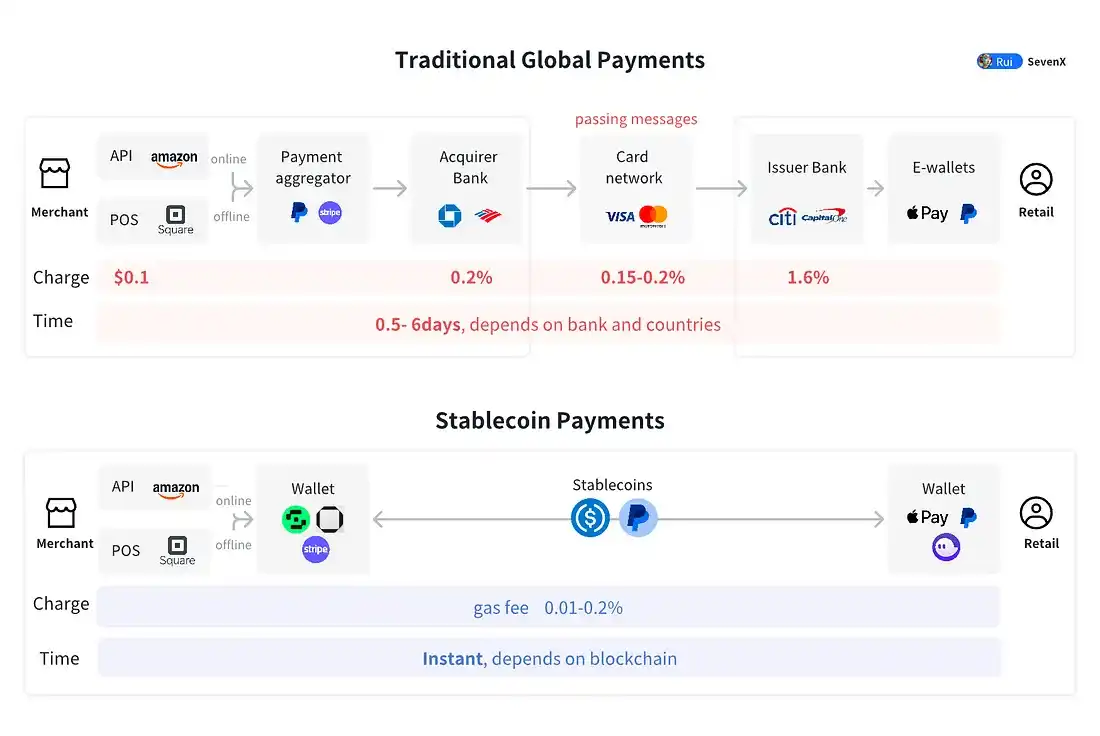
With trusted issuers, healthy banking relationships, and distributors as a foundation, stablecoins can enhance efficiency in large-scale financial systems, especially in the payment sector.
Traditional systems face efficiency and cost constraints. Internal applications or bank transfers provide instant settlement but are limited to their ecosystems. The cost of interbank payments is about 2.6% (70% paid to the issuing bank, 20% to the acquiring bank, and 10% to the card network), with settlement taking more than a day. Cross-border transactions are even more expensive, averaging around 6.25%, with settlement times reaching up to five days.
Stablecoin payments provide point-to-point instant settlement by eliminating intermediaries. This accelerates capital flow, reduces capital costs, and offers programmable features like conditional automatic payments.
B2B (annual transaction volume of $120–150 trillion): Banks are in the best position to drive stablecoins. In October 2023, JPM Coin developed by JPMorgan has been used for approximately $1 billion in daily transactions on its Quorum chain.
P2P (annual transaction volume of $1.8–2 trillion): E-wallets and mobile payment applications are well-positioned, with PayPal launching PYUSD, currently valued at $604 million on Ethereum and Solana. PayPal allows end users to register and send PYUSD for free.
B2C e-commerce (annual transaction volume of $5.5–6 trillion): Stablecoins need to collaborate with POS systems, banking APIs, and card networks. Visa became the first payment network to allow transactions to be settled in USDC back in 2021.
Pioneers in the "Underbanked" World, Shadow Dollar Economy
Due to severe currency devaluation and economic instability, developing markets urgently need stablecoins. In Turkey, the volume of stablecoin purchases accounts for 3.7% of its GDP. People and businesses are willing to pay a premium for stablecoins above fiat dollars, with stablecoin premiums reaching 30.5% in Argentina and 22.1% in Nigeria. Stablecoins provide access to dollars and financial inclusion.
Tether dominates this space, backed by a reliable 10-year track record. Even amid complex banking relationships and redemption crises—Tether admitted in April 2019 that USDT was only 70% backed by reserves—its stability remains intact.
This is because Tether has built a robust shadow dollar economy: in developing markets, few people convert USDT back to fiat; they view it as dollars, a phenomenon particularly evident in Africa and Latin America, where it is used for paying employees, bills, and more. Tether has achieved this through long-standing presence and consistent utility, enhancing its credibility and acceptance without providing incentives. This should be the ultimate goal for every stablecoin.
Dollar Access
Remittances: Remittance inequality slows economic growth. Economic actors in Sub-Saharan Africa are charged an average of 8.5% in remittance fees when sending money to low- and middle-income countries and developed nations. For businesses, high remittance costs, long processing times, bureaucratic hurdles, and exchange rate risks directly impact growth and competitiveness in the region.
Dollar access: Costs from currency fluctuations caused a GDP loss of $1.2 trillion for 17 developing countries between 1992 and 2022, accounting for 9.4% of their total GDP. Access to dollars is crucial for local financial development. Many crypto projects focus on entry through "DePIN" methods, which leverage local agents to facilitate cash-to-stablecoin transactions in Africa, Latin America, and Pakistan.
Foreign exchange: Today, the daily trading volume of the foreign exchange market exceeds $7.5 trillion. In the Global South, individuals often exchange local fiat for dollars through black markets, primarily because black market rates are more favorable than official channels. Binance's P2P trading is beginning to be adopted, but it lacks flexibility due to its order book model. Many projects, such as ViFi, are building on-chain automated market maker foreign exchange solutions.
Humanitarian aid distribution: Ukrainian war refugees can receive humanitarian aid in the form of USDC, which can be stored in digital wallets or cashed out locally. In Venezuela, frontline healthcare workers used USDC to pay for medical supplies during the pandemic, despite the worsening political and economic crisis.
Conclusion: Interconnectivity
Interoperability: As stablecoins gain widespread adoption and different ecosystems merge, interoperability becomes a core challenge and opportunity for the future development of stablecoins. Enhancing liquidity across currencies, chains, and currencies will be key to advancing this field.
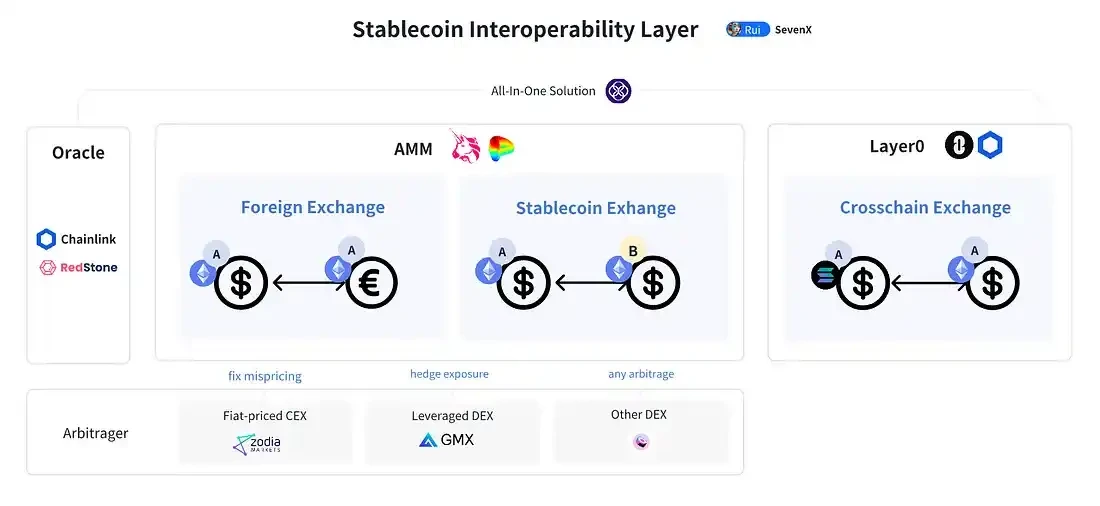 Traditional foreign exchange systems are inefficient and face multiple challenges:
Traditional foreign exchange systems are inefficient and face multiple challenges:
Counterparty settlement risk (CLS has improved but remains cumbersome)
Costs of multi-bank systems (for example, conducting yen purchases in Australia requires six banks to participate and must be completed through a London dollar office)
Global settlement time zone differences (for example, the banking systems for Canadian and Japanese dollars overlap for less than five hours each day)
Limited access to the foreign exchange market (retail users pay fees that are 100 times those of large institutions)
Blockchain foreign exchange (Onchain FX) offers significant advantages:
Cost, efficiency, and transparency: Oracles like Redstone and Chainlink provide real-time price quotes. Decentralized exchanges offer efficient cost control and transparency, with Uniswap's concentrated liquidity market makers (CLMM) reducing trading costs to 0.15-0.25%, approximately 90% lower than traditional foreign exchange. Moving from T+2 bank settlements to instant settlements allows arbitrageurs to adopt various strategies to correct pricing imbalances.
Flexibility and accessibility: Blockchain foreign exchange enables corporate finance professionals and asset managers to access a variety of products without the need for multiple currency-specific bank accounts. Retail users can obtain the best foreign exchange prices using crypto wallets with embedded DEX APIs.
Separation of currency and jurisdiction: Transactions no longer require domestic banks, allowing for the separation of currency and jurisdiction. This approach leverages the efficiency of digitization while maintaining monetary sovereignty, though it still has its pros and cons.
However, challenges remain, including the scarcity of non-dollar-denominated digital assets, the security of oracles, support for long-tail currencies, regulatory issues, and the unified interface with on-chain/off-chain. Nevertheless, blockchain foreign exchange still offers rich opportunities. For example, Citibank is developing a blockchain foreign exchange solution under the guidance of the Monetary Authority of Singapore.
Stablecoin Exchanges
Imagine a world where most companies issue their own stablecoins; stablecoin exchanges pose a challenge: how to use PayPal's PYUSD to pay merchants at JP Morgan. While bridges between on-chain and off-chain can solve this issue, they lose the efficiency promised by cryptocurrencies. Blockchain automated market makers provide optimal real-time low-cost stablecoin-to-stablecoin trading.
For instance, Uniswap offers some liquidity pools with fees as low as 0.01%. However, once billions of dollars enter the blockchain, they must rely on the security of smart contracts and must have sufficiently deep liquidity and instant performance to support real-life activities.
Cross-Chain Exchanges
Major blockchains have their own advantages and disadvantages, leading to the need for stablecoins to be deployed across multiple chains. A multi-chain approach brings cross-chain challenges, and bridging technologies pose significant security risks. My view is that stablecoins should launch their own Layer 0 (zero-layer protocol), such as USDC's CCTP, PYUSD's Layer 0 integration, and a similar Layer 0 solution that USDT might launch for recycling bridged locked tokens.
Meanwhile, several open questions remain:
Will regulation undermine "open finance," considering that compliant stablecoins may monitor, freeze, and withdraw funds?
Can compliant stablecoins still avoid providing yields that could be seen as securities products, thereby preventing on-chain decentralized finance from benefiting from its large-scale expansion?
Can any open blockchain handle massive funds, given Ethereum's slow transactions, its L2 relying on a single sequencer, Solana's imperfect launch record, and other hyped blockchains lacking long-term stability records?
Will the separation of currency and jurisdiction lead to more confusion or opportunities?
The prospect of a financial revolution led by stablecoins is both exciting and uncertain—a new chapter where regulation and freedom dance in a delicate balance.
免责声明:本文章仅代表作者个人观点,不代表本平台的立场和观点。本文章仅供信息分享,不构成对任何人的任何投资建议。用户与作者之间的任何争议,与本平台无关。如网页中刊载的文章或图片涉及侵权,请提供相关的权利证明和身份证明发送邮件到support@aicoin.com,本平台相关工作人员将会进行核查。



